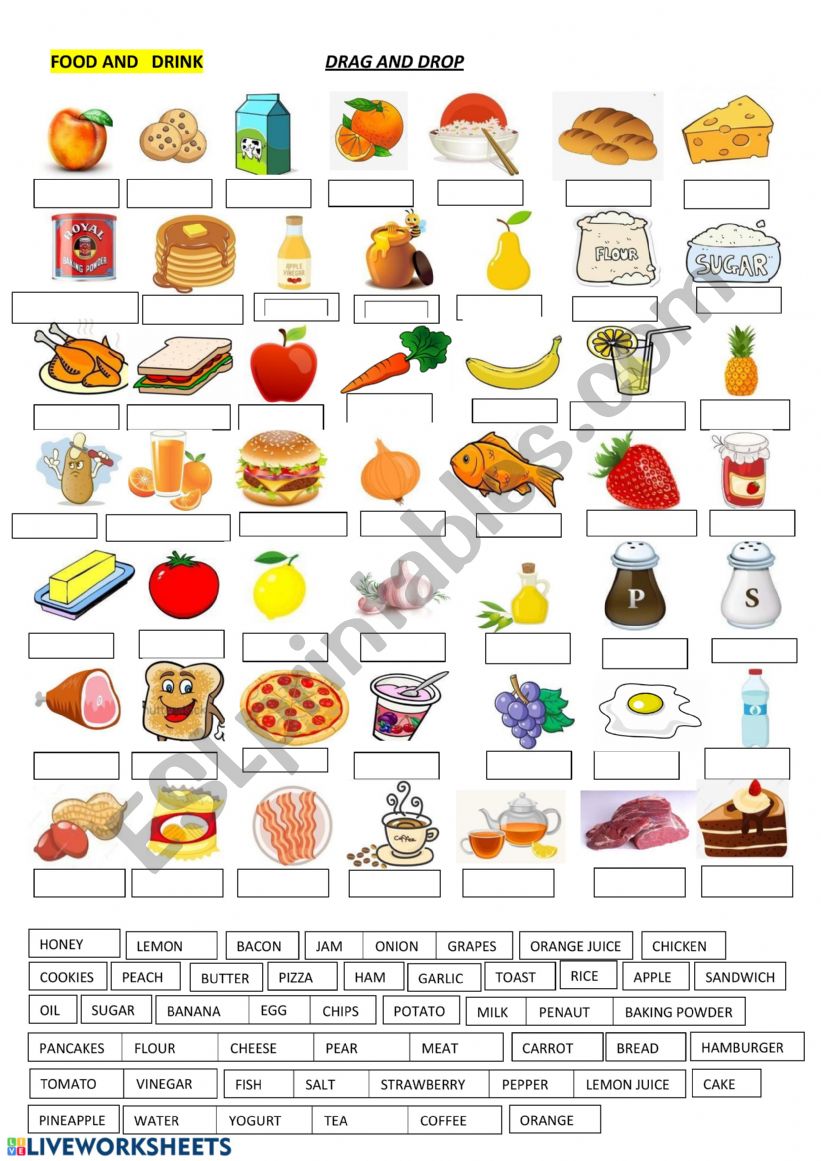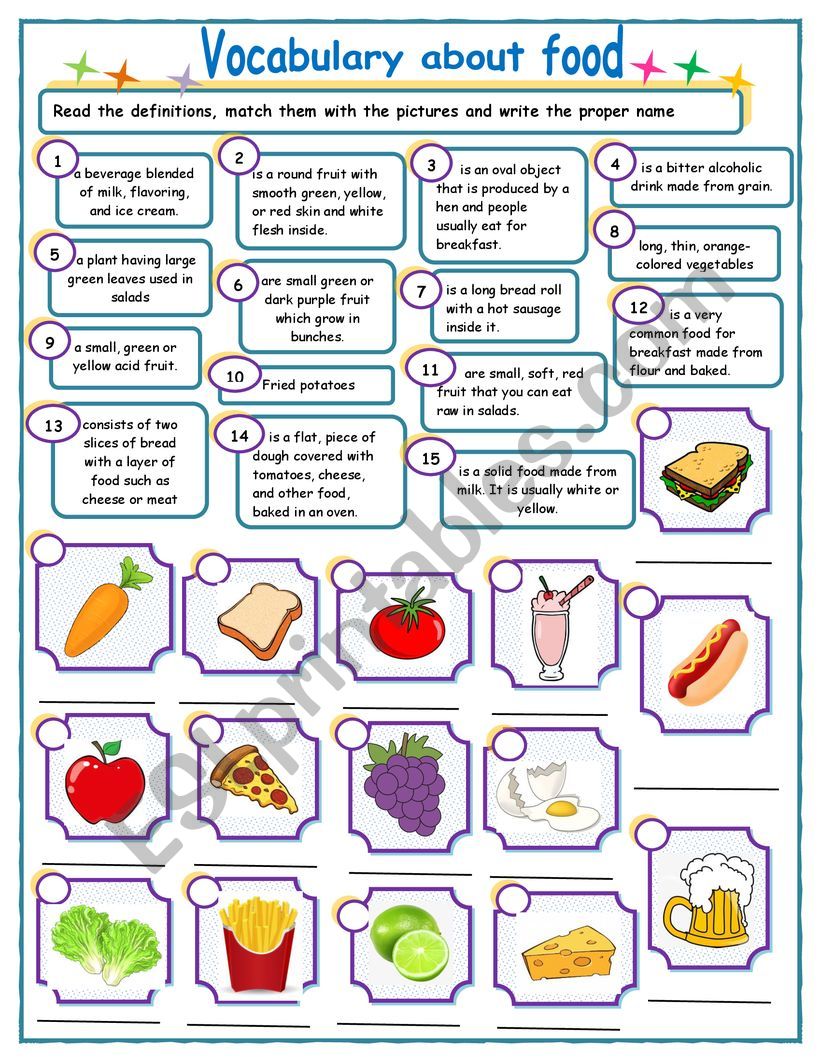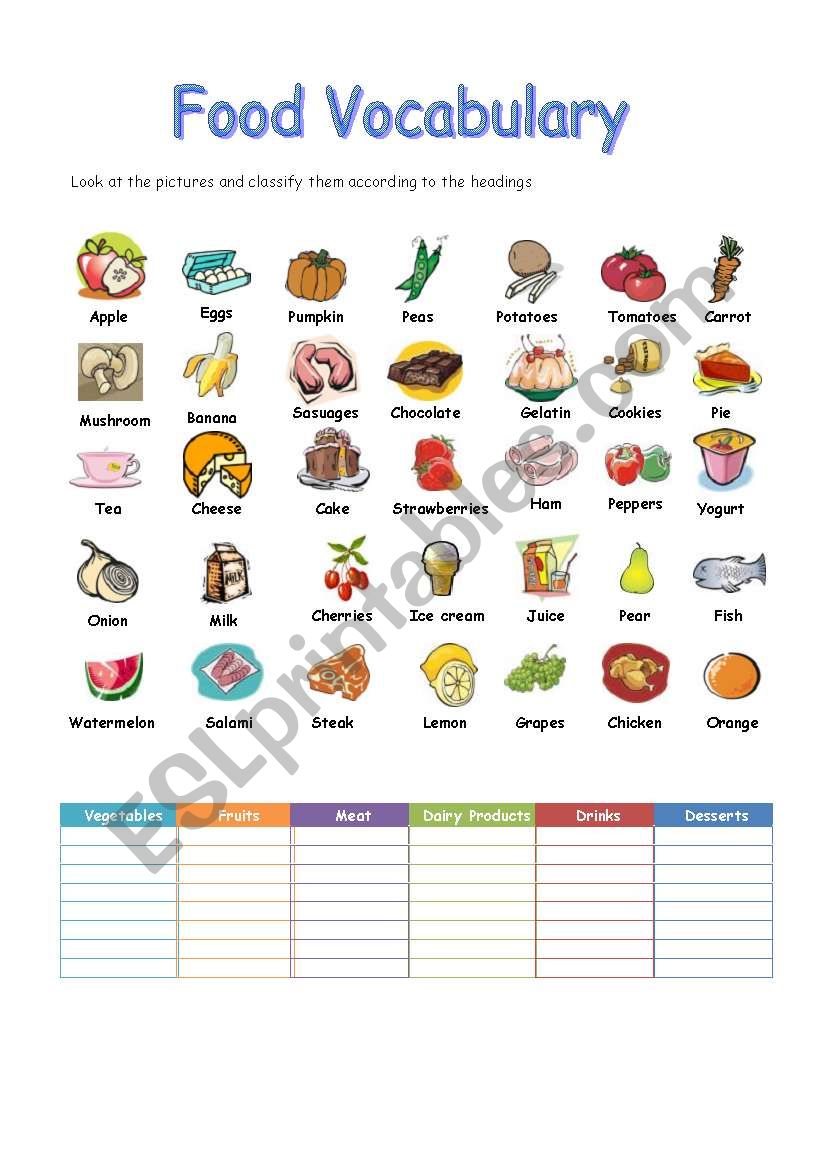
Mastering Culinary English: The Indispensable Role of Food Vocabulary Worksheets
In a world increasingly connected by diverse cultures and shared experiences, the ability to communicate effectively about food is more vital than ever. From ordering in a foreign restaurant to discussing dietary needs, or even simply following a recipe, a robust vocabulary related to food is an indispensable asset. While there are numerous methods for language acquisition, food vocabulary worksheets stand out as a highly effective pedagogical tool, offering structured, engaging, and practical pathways to mastering the lexicon of the kitchen and dining table.
The Universal Language of Food and the Need for Specific Vocabulary

Food is more than just sustenance; it’s culture, tradition, art, and a common ground for human connection. Every language has a rich and extensive vocabulary dedicated to food, encompassing everything from ingredients and cooking methods to tastes, textures, and mealtime customs. For language learners, especially those studying English as a second or foreign language (ESL/EFL), acquiring this specific vocabulary is crucial for several reasons:

- Daily Life & Practicality: Navigating a grocery store, reading food labels, ordering at a restaurant, or participating in a dinner conversation all require a strong grasp of food terms. Without it, even simple tasks can become daunting.
- Health & Dietary Needs: Communicating allergies, intolerances, or dietary preferences (vegetarian, vegan, gluten-free, etc.) accurately is essential for personal health and safety.
- Cooking & Recipes: Understanding verbs like "chop," "sauté," "bake," and "simmer," along with ingredient names and measurements, is fundamental for anyone wanting to cook or follow recipes in English.
- Cultural Understanding: Food is deeply intertwined with culture. Learning food vocabulary often opens doors to understanding traditions, festivals, and social norms.
- Travel: Exploring new places often involves sampling local cuisine. A good food vocabulary enhances the travel experience, allowing for richer interactions and discoveries.
- Professional Contexts: For those working in hospitality, culinary arts, nutrition, or international business, precise food vocabulary is a professional necessity.




Given this extensive need, the question then becomes: how can learners most effectively acquire and retain this vast amount of information? This is where food vocabulary worksheets prove their worth.
The Power of Worksheets in Vocabulary Acquisition

Worksheets, often perceived as traditional learning tools, are incredibly versatile and powerful for vocabulary acquisition. They provide:
- Structured Practice: Unlike passive learning, worksheets demand active engagement, reinforcing new words through repetition and application.
- Variety of Activities: They can incorporate different learning styles, appealing to visual, auditory, and kinesthetic learners through diverse tasks.
- Self-Paced Learning: Learners can work at their own speed, revisiting difficult concepts and progressing when ready.
- Measurable Progress: Completing worksheets provides a tangible sense of accomplishment and allows learners (or instructors) to track progress.
- Reinforcement: The act of writing, matching, or categorizing words helps solidify them in memory.
- Contextual Learning: Good worksheets present vocabulary within meaningful contexts, aiding comprehension and retention.


Among the most versatile and impactful educational resources are food vocabulary worksheets, which are specifically designed to immerse learners in the world of culinary English.
Types of Effective Food Vocabulary Worksheets
The beauty of food vocabulary worksheets lies in their adaptability. They can be tailored to various proficiency levels, age groups, and learning objectives. Here are some popular and effective types:
-
Matching Worksheets:
- Word to Picture: Learners match a written word (e.g., "apple") to its corresponding image. Ideal for beginners and visual learners.
- Word to Definition: Matching a food item or cooking verb to its description. Useful for building understanding beyond simple recognition.
- Word to Category: Matching individual food items to broader categories (e.g., "carrot" to "vegetables," "milk" to "dairy").
- Dish to Origin/Cuisine: Matching famous dishes to their country of origin or culinary style (e.g., "sushi" to "Japan").
-
Fill-in-the-Blanks Worksheets:
- Contextual Sentences: Learners complete sentences using appropriate food vocabulary from a word bank. Example: "I need to _____ the onions before adding them to the soup." (chop/slice/dice). This encourages understanding of usage.
- Recipe Steps: Filling in missing verbs or ingredients in a simplified recipe.
- Dialogue Completion: Completing a conversation set in a restaurant or grocery store.
-
Crosswords and Word Searches:
- Crosswords: Clues can be definitions, synonyms, or descriptions related to food. Excellent for challenging recall and spelling.
- Word Searches: Fun for recognizing words within a grid, especially useful for reinforcing spelling.
-
Categorization Worksheets:
- Sorting: Providing a list of food items and asking learners to sort them into categories like fruits, vegetables, grains, proteins, dairy, spices, etc. This helps organize knowledge semantically.
- Healthy vs. Unhealthy: Categorizing foods based on their nutritional value.
- Sweet vs. Savory: Distinguishing between different taste profiles.
-
Sentence Construction/Writing Prompts:
- Using New Words: Learners create their own sentences using a given set of food vocabulary words.
- Descriptive Writing: Prompts like "Describe your favorite meal" or "Write a review of a restaurant," encouraging the use of descriptive adjectives (spicy, creamy, crunchy) and verbs.
- Recipe Writing: Learners write a simple recipe for a dish they know, applying all relevant vocabulary.
-
"Odd One Out" Worksheets:
- Presenting a list of words, where one word doesn’t fit the category (e.g., "apple, banana, carrot, orange" – "carrot" is the odd one out). This tests classification skills.
-
Picture Description Worksheets:
- Providing an image of a meal, a grocery store aisle, or a kitchen scene, and asking learners to describe what they see using specific food vocabulary.
-
Menu/Shopping List Creation:
- Learners create a menu for a hypothetical restaurant or a shopping list for a week’s groceries. This is highly practical and encourages real-world application.
-
Dialogue and Role-Playing Scenarios:
- Worksheets providing skeletal dialogues for restaurant ordering, grocery shopping, or discussing food preferences, with blanks for learners to fill in or prompts for role-playing.
-
Flashcard Worksheets:
- Templates for creating flashcards with a picture on one side and the word/definition on the other. Learners can cut them out and use them for self-study.
Designing and Utilizing Effective Food Vocabulary Worksheets
To maximize the effectiveness of food vocabulary worksheets, consider the following design principles and utilization strategies:
- Clear Learning Objectives: Each worksheet should have a specific goal, whether it’s to learn names of fruits, cooking verbs, or adjectives for taste.
- Age and Proficiency Appropriate: The complexity of vocabulary and tasks should match the learners’ level. Beginners need more visual support and simpler tasks, while advanced learners can handle abstract concepts and more complex sentence structures.
- Visual Appeal: Incorporate clear, appealing images. For food, visuals are incredibly powerful in aiding comprehension and memory.
- Real-World Context: Present vocabulary in situations learners are likely to encounter. This makes the learning relevant and memorable.
- Variety is Key: Don’t stick to just one type of worksheet. Mix matching with fill-in-the-blanks, crosswords, and writing tasks to keep learners engaged and cater to different learning styles.
- Provide Answer Keys: For self-study, an answer key is crucial for immediate feedback and correction.
- Encourage Interaction: While worksheets can be independent, they can also be used for pair or group work, fostering discussion and collaborative learning.
- Integrate with Other Activities: Worksheets are most effective when part of a broader learning strategy. Follow up a worksheet on cooking verbs with a simple cooking demonstration or a discussion about favorite recipes. Visit a grocery store or a local market to see the vocabulary in action.
- Scaffolding: Introduce new vocabulary gradually. Start with basic categories (fruits, vegetables), then move to more specific terms (exotic fruits, types of cheeses), then to verbs, adjectives, and idiomatic expressions.
- Repetition with Variation: Repetition is essential for memory, but it doesn’t have to be boring. Present the same words in different worksheet formats over time.
Benefits Across Different Learner Groups
- For ESL/EFL Students: Worksheets provide systematic exposure and practice, building confidence in everyday communication about food. They help bridge the gap between passive understanding and active use.
- For Young Learners: Fun, colorful worksheets with engaging activities make learning food vocabulary enjoyable and memorable, laying a strong foundation for future language development.
- For Adults: Worksheets can cater to specific needs, such as preparing for travel, enhancing culinary skills, or improving conversational fluency for social events.
- For Self-Study: Learners can work independently, at their own pace, making worksheets an ideal resource for supplementary learning outside of a classroom setting.
The journey to mastering English food vocabulary is significantly enhanced by well-designed food vocabulary worksheets. They transform what could be a mundane memorization task into an interactive and enjoyable learning experience.
Conclusion
In a world that celebrates culinary diversity and global exchange, effective communication about food is no longer a luxury but a necessity. Food vocabulary worksheets offer a robust, adaptable, and engaging solution for learners of all ages and levels to acquire and solidify this essential linguistic skill. By providing structured practice, diverse activities, and real-world context, these worksheets empower individuals to confidently navigate menus, discuss recipes, share cultural food experiences, and ultimately, enrich their linguistic repertoire. Their versatility makes them an indispensable resource for educators and self-learners alike, truly paving the way for mastering culinary English.
